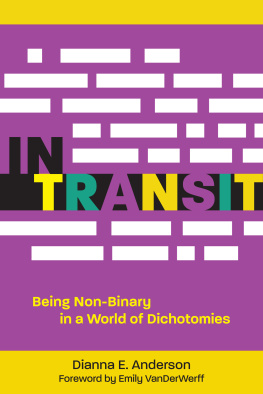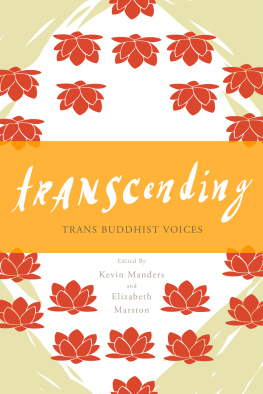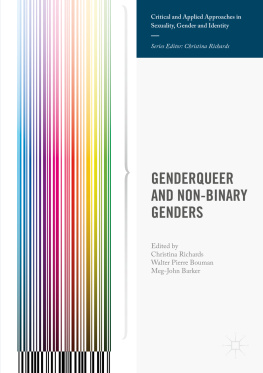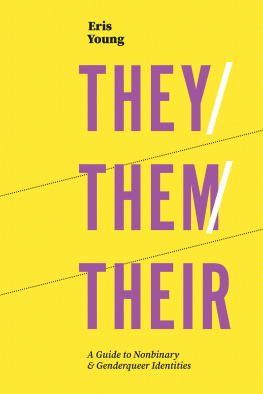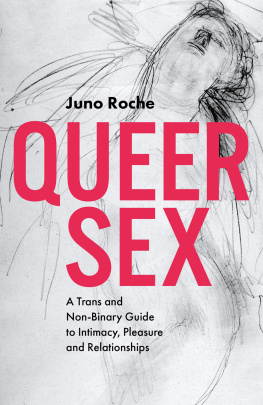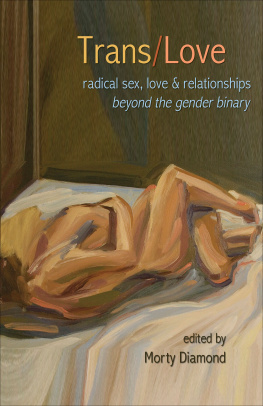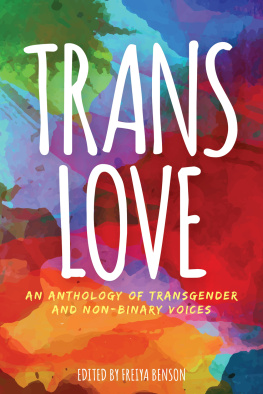
Burn the Binary!: Selected Writing on the Politics of BeingTrans, Genderqueer and Nonbinary 2017 by Riki Wilchins
All Rights Reserved. No part of thisbook may be reproduced or transmitted in any form or by any means, electronicor mechanical, including photocopying, without permission in writing from thepublisher.
For more information contact:
Riverdale Avenue Books
5676 Riverdale Avenue
Riverdale, NY 10471
www.riverdaleavebooks.com
Design by www.formatting4U.com
Cover by Scott Carpenter
Cover illustration by BlakeChamberlain.
The majority of these articles werepublished on the Advocate.com between 2007 and 2018 and are used withpermission of the author.
Digital ISBN: 978-1-62601-406-0
Print ISBN: 978-1-62601-407-7
First edition, October 2017
Acknowledgments
Special thanks to Camila Saly fortaking this volume to heart, and for her incredibly close read. To ClareHowell, for reading everything I ever wrote and then helping select the rightpiecesyou somehow always make my books come together and make sense. To mypublisher, Lori Perkins at Riverdale, for having the idea for this book, andfor somehow finding Blakes incredible artwork. To Blake Chamberlain for hiscreative talent and passion in creating the piece that inspired this book,which then became its cover. And to Gina and Dylan Jade, who tolerate my longlate nights writingyou are my life.
Table of Contents
Part I -- Articles from TheAdvocate. Advocate.com (and other Outlets)
PartI II --From Read My Lips: SexualSubversion and the End of Gender
Part III --from Genderqueer: Voicesfrom Beyond the Sexual BinaryThe Gender Cops

Introduction: An Interview with Riki Wilchins
I met Riki in the fall of 1994 afterId sought a trans-support group at the Gay and Lesbian Community Center in NewYork City. Lynn Walker, the moderator of the group I first attended there,steered me to another informal group that met outside the Center. I knew themoment I walked into her apartment that Riki was onto something I needed toknow. Each of us got something from that first meetingshe an editor, and me anexample of lived experience I could relate to, finally.
This volume is a good sample of Rikis work, beginning witha selection of her articles written for The Advocate magazine(Advocate.com, and other outlets), from 2000 through August, 2017, This isfollowed by selections from Read My Lips: Sexual Subversion and the End ofGender (1997), a collection of early writings that highlights herdeveloping theoretical critique of gender and the nature of binaries,illustrated by her experience in confronting life as a young genderqueer.Finally, from Genderqueer: Voices from Beyond the Sexual Binary (2002),the anthology she, Joan Nestle, and I edited of works by genderqueers and thosewho love us, comes a concise explanation of her understanding of the nature ofgender and sexuality, and the problems we face.
We begin with an interview I did with Riki, to set the tablefor what follows:
When I first moved to NYC, I was a rangy Southern lesbianand newly-minted transsexual, trying to figure out how I was going to survive.And then I met you through a mutual friend at a Menace meeting, and youwere doing this queer theory rap and doing some sort ofnot-exactly-boy-or-girl genderqueer thing, and I thought, Yeah, thats how Iwant to do it. If I could.
Except for the fact that I was Midwestern, another rangylesbian and newly-minted transsexual, and I was still trying to figure out howI was going to do it. But I didnt fit any of the models out there. I didntreally want to wear dresses much or put on make-up. Even when I did, while Isometimes enjoyed it, I didnt look much like a cisgender woman. I had alwaysbeen a total jock, and I had never had any real sexual attraction to men. So Iknew I didnt fit neatly in one of the allowable binary boxes. And I kepttalking about genderqueer-ness, about breaking down the categories, and the problemsof identity. I knew there was something there (and God knows the old modeldidnt work for me), but I had no idea what I was talking about. And I keptthinking, One day, someone is going to tell me what Im onto. And sureenough, a lesbian feminist friend hooked me up with Judith Butlers GenderTrouble, and that kind of ate the next 10 years of my life. It finally gaveme a coherent set of tools to understand, and, perhaps more importantly, tofinally deconstruct this oppressive gender system Id been bumping up againstsince the day I announced my transition. In many ways, queer theory pretty muchsaved my life, or at least my sanity.
Some people would say that while it was once radical andedgy, postmodernism and what are seen as its offspring, queer and gendertheory, is now a spent force. What are your thoughts?
Its probably a bit of a spent force in academia. Im notsure that its a spent force in popular culture yet. Im not sure it will befor some time. Among other things, queer theory offers a very deep and profoundcritique of how we understand these various Selvesgay, white, trans, etc.andthese bodies we think of ourselves as inhabiting. I think this will take sometime to be fully absorbed. At the same time, somewhat like feminism - whichsome people often describe as an an old or spent force, what that really meansis that the things it advocated have moved from the margins to conventionalwisdom. For instance, except for the alt-right, everyone now accepts equal payfor equal work, a womans right to control her own childbearing, that women canbe leaders, even presidents, etc. That same kind of intense fertilization ofpopular culture is now taking place with queerness as well. You can hardly lookat any media outlet today and not read someone talking about being Other:that is a concept straight out of postmodernism. So is the increasing number ofkids who refuse to identify as L, G, B, or T, and just say Im genderqueer.We hear increasingly about intersectionality, another concept straight out ofCritical Race Theory which is itself connected to postmodernism. And thentheres the rise of new, nonbinary identities, which in some ways is the flowerof gender theory, one that is just coming into its own. People are finally startingto break down boundaries and identities in very fertile and productive ways.And were not just militating for the right to change sexes: the whole idea ofbinary sexes is finally under full assault. So I think were just starting on areally interesting ride here.
Twenty years ago you were way ahead of the curve ongender, and now it seems that young genderqueers have gone far upstream ofthat. Many LGBTQ people can only stare in amazement at what theyre doing. Whatare your thoughts on how far, and how quickly, weve come on this issue?
As I wrote in my last book, TRANS/gressive (a historyof the trans movement), sometimes it seemed it was impossible to make anychange at all, and at other times I look back and it feels like it all happenedalmost overnight. I think things reach a tipping point when they hit criticalmass, and things start to take off. I think thats happening here. It took usnearly 20 years to just establish trans as an issue. It took about that longfor the ideas in queer theory and deconstruction to get intellectual traction,so that people could finally understand that rigid binary gender regimes areboth socially constructed and highly oppressive. As a result, now you finallysee things taking off politically, socially, and intellectually. But just astrans is finally coming into its own, young people are exploding it and takingit to a whole new place. I tried to point out in Read My Lips that the wholemale-to-female / female-to-male transgender paradigm, with which many of usgrew up, in many ways required, and even reinforced, a rigid gender binary. SoI welcome the fact that some young people are moving beyond this into thingslike genderqueer and nonbinary. We really do need to burn the binary.
Next page

